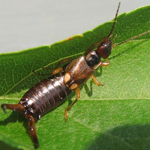Biology
- This insect is cosmopolitan in cooler parts of the world.
- It is normally omnivorous, feeding on both plant and animal materials and is largely beneficial as it constitutes a major food source for many other insects.
- In areas where they are known to have population explosions (newly introduced areas), they tend to damage flower blossoms and get into houses (they prefer dark places). They cause no damage to houses but their presence is usually a nuisance. They do not breed indoors.
- They are most active in July through September.
- An adult earwig is about 1.5 to 2 cm long. It has a tough, reddish-brown exoskeleton with prominent pincers extending out from the rear. These insects also have wings, though they cannot lift from the ground. They must take off from a high place in order to fly.
- Earwigs only live for 1 year. In the spring, females lay as many as 60 round, white eggs in the top 5 cm of the soil. About 1/5 of the females will lay a second batch of eggs in June. These will appear in July and August.
- They prefer cool, dark, moist places. They come out of hiding at dusk in order to feed.
How to Control
- Since earwigs overwinter and females will lay their eggs just below the soil surface, turning the soil over to expose them and the eggs is an easy way to control their numbers. Most will either dry out or will be eaten by predators.
- Keep the lawn free of decaying matter: rake up all grass clippings, fallen leaves, etc.
- Sprinkle Insectigone® around all foundations and areas that are infested with earwigs.
- Make your own trap by bundling some old rubber hose or tubing under vegetation, against a fence, etc. Empty the trap every morning into a pail of hot, soapy water. Two pieces of corrugated cardboard or grooved wood stuck together with a rubber band and standing on end can work as well.
- Spread some peanut butter on a newspaper and crumple it up. Place it in the garden and collect the trapped insects every morning. Put the earwigs in hot, soapy water.
- For outdoor control, bury shallow aluminium pie pans to their rims in the soil and fill them partly with soil and oil. This traps many of the insects. Fish oil is the best oil to use since it attracts the earwigs. Unrinsed juice containers filled 2/3 of the way up with water and topped with detergent can work as well.
- For more tips go to Earwig Controls

